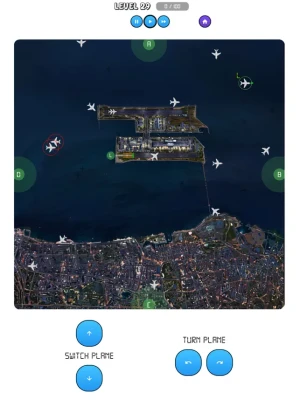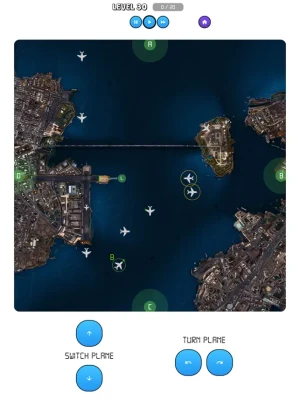
Latest Version
1.0.1
June 18, 2025
The flight control simulator
Games
iOS
104.8 MB
0
Free
Report a Problem
More About Air Traffic Control: ATC Game
The Crucial Role of Air Traffic Controllers: Ensuring Safe Skies
The safety of countless passengers depends on the expertise of air traffic controllers (ATCs) as they navigate aircraft to their designated destinations. A single miscalculation can lead to disastrous consequences, making the role of an ATC one of the most critical in the aviation industry.
The Responsibilities of Air Traffic Controllers
Air traffic controllers are tasked with the monumental responsibility of managing the flow of air traffic in controlled airspace. Their duties include:
- Providing clear instructions to pilots during takeoff and landing.
- Monitoring aircraft positions and ensuring safe distances between planes.
- Coordinating with other ATCs to manage traffic across different regions.
- Responding swiftly to emergencies and unexpected situations.
Each of these responsibilities requires a high level of concentration, quick decision-making skills, and the ability to remain calm under pressure. The stakes are incredibly high, as the safety of passengers and crew members hinges on their performance.
The Skills Required to Become an Air Traffic Controller
To excel as an air traffic controller, individuals must possess a unique set of skills, including:
- Exceptional Communication Skills: Clear and concise communication is vital in relaying instructions to pilots and coordinating with other controllers.
- Strong Analytical Abilities: Controllers must analyze complex data quickly to make informed decisions regarding air traffic management.
- Attention to Detail: A keen eye for detail helps in identifying potential issues before they escalate into serious problems.
- Stress Management: The ability to remain composed in high-pressure situations is essential for effective decision-making.
These skills are not only crucial for the day-to-day operations of air traffic control but also play a significant role in ensuring the overall safety of the aviation industry.
The Training Process for Air Traffic Controllers
Becoming an air traffic controller is no small feat. The training process is rigorous and involves several stages:
- Educational Requirements: Most ATCs hold a degree in aviation management, air traffic control, or a related field. Some may also complete specialized training programs.
- Certification: Candidates must pass the FAA's Air Traffic Selection and Training (AT-SAT) test, which assesses their aptitude for the role.
- On-the-Job Training: Once selected, trainees undergo extensive on-the-job training at an FAA facility, where they learn to manage air traffic under the supervision of experienced controllers.
- Continuous Education: Even after becoming certified, ATCs must participate in ongoing training to stay updated on new technologies and procedures.
This comprehensive training ensures that air traffic controllers are well-prepared to handle the complexities of air traffic management.
The Impact of Technology on Air Traffic Control
Advancements in technology have significantly transformed the field of air traffic control. Modern ATCs utilize sophisticated radar systems, automated tools, and communication technologies to enhance their efficiency and accuracy. Some key technological innovations include:
- NextGen Air Traffic Control: This initiative aims to modernize the air traffic control system in the United States, improving safety and efficiency through satellite-based navigation.
- Automated Flight Data Processing: Automation helps streamline data management, allowing controllers to focus on critical decision-making tasks.
- Enhanced Communication Systems: Advanced communication technologies facilitate real-time information sharing between pilots and controllers, reducing the likelihood of misunderstandings.
These technological advancements not only improve the efficiency of air traffic management but also contribute to the overall safety of air travel.
The Future of Air Traffic Control
As the aviation industry continues to evolve, the role of air traffic controllers will also adapt to meet new challenges. The future may see:
- Increased Automation: While human oversight will remain essential, automation will likely play a larger role in managing routine tasks, allowing controllers to focus on more complex situations.
- Integration of Unmanned Aerial Vehicles (UAVs): As drone technology advances, ATCs will need to develop new protocols for safely integrating UAVs into controlled airspace.
- Global Collaboration: Enhanced international cooperation among air traffic control agencies will be crucial for managing the growing volume of global air traffic.
These developments will shape the future landscape of air traffic control, ensuring that safety remains the top priority as air travel continues to expand.
Conclusion: The Unsung Heroes of Aviation
Air traffic controllers are the unsung heroes of the aviation industry, working tirelessly behind the scenes to ensure the safety and efficiency of air travel. Their expertise, dedication, and ability to perform under pressure are vital to the success of the aviation system. As technology advances and the industry evolves, the importance of skilled air traffic controllers will only continue to grow, making their role more critical than ever.
Rate the App
User Reviews
Popular Apps










Editor's Choice




























